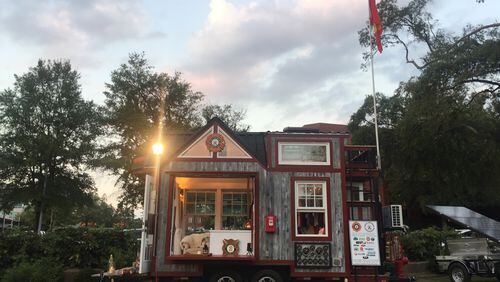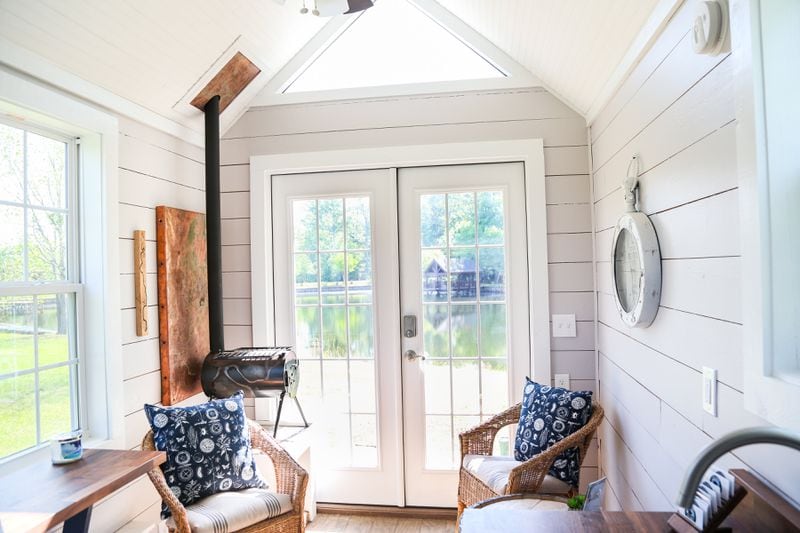It has been almost a decade since John Kernohan found himself in a hospital bed in Florida having the kind of white light moment that people talk about on television.
He was living in Miami Shores at the time, working seven days a week, making lots of money, living in a big house and driving fancy cars.
“I was the jerk guy you see going down the street in the Corvette,” he said. But at that moment in the hospital -- a moment that later led to his diagnosis with a neurological disorder -- he decided he was ready for a change.
He sold his business, got rid of his cars and began dating his future wife, Fin. After just over a year, they exchanged hose clamps from Home Depot as engagement rings and began building their dream home.
When his wife shot down the 1,200 square foot home he wanted to build and asked for something smaller, Kernohan became an official member of the tiny house movement. It took 18 months for them to build their 304 square foot tiny house called “Beloved Cabin.”
Related: Atlanta couple's tiny house turned into a hot property
Two years ago, when Fin tired of hearing him complain about the lack of tiny house events on the East coast, Kernohan created his own event. The first Georgia Tiny House Festival took place March 2016 in their hometown of Eatonton with 19 tiny structures on display and more than 5,000 visitors.
“Our claim to fame is we know nothing about what we are doing. We didn’t know there was a playbook for tiny house festivals,” Kernohan said. But since then, their efforts have grown into a multi-state event that draws thousands of attendees and donates thousands of dollars to local charities.
On March 2 - 4, the third annual Georgia Tiny House Festival takes place at the Atlanta Motor Speedway in Hampton and it is bigger than ever. In addition to 90 structures to view and tour there will be keynote speakers including Zach Giffin of FYI’s Tiny House Nation and Atlanta’s own tiny house advocate, Will Johnston.
The festival also functions as a fundraiser for more than 20 charities which will receive a portion of the proceeds as donations. Visitors will enjoy a festival atmosphere with music including Lynyrd Skynyrd’s Artimus Pyle and Atlanta’s The TxLips.
After Kernohan and his wife hosted the first festival they began getting calls from campgrounds and RV dealers around the country asking them to host similar festivals in different cities. They agreed, but only on their terms, Kernohan said.
“The thing that separates our events from other events is ours is a big philanthropy effort,” he said. The goal is to promote awareness of the tiny house movement while also serving as a source of philanthropy to benefit charities in the states where the events are held, he said.
With proceeds from past festivals, the United Tiny House Association has funded the building of two tiny houses for families in need. A third home is underway for a displaced family in Texas. The organization has also endowed the annual Tiny House Scholarship Fund.
The tiny house movement is evolving rapidly, Kernohan said. Once defined as homes that are 500 square feet or less, even the very definition of a tiny home has changed. Now a tiny home is widely defined as being a home under 400 square feet.
Kernohan, however, said the term “tiny”is relative. “If someone is living in 3,000 square feet and they downsize to 800 square feet, who am I to tell them they are not living tiny?” he said.
State and local governments, with Georgia at the forefront, are looking at the standards for tiny houses, particularly homes that are DIY, and many are considering tiny homes as options for affordable housing. Changes in materials and technology have allowed builders to be even more creative when designing tiny homes.
The financial crisis gave everyone a chance to step back and redefine what is really important, Kernohan said. Homeowners today are more interested in having a home they can own and not be owned by.
“There is something empowering about owning a piece of real estate,” Kernohan said. “It makes people feel good.”
For more information and festival schedule visit UnitedTinyHouse.com.
About the Author








